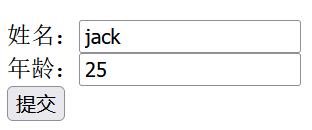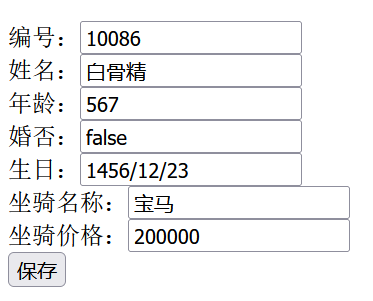SpringBoot接收参数相关注解
1.基本介绍
- SpringBoot接收客户端提交数据/参数会使用到相关注解
- 详解@PathVariable、@RequestHeader、@ModelAttribute、@RequestParam、@CookieValue、@RequestBody
2.接参数相关注解应用实例
演示各种方式提交数据/参数给服务器,服务器如何使用注解接收
2.1@PathVariable
通过@RequestMapping和@PathVariable,获取映射路径的占位符匹配的参数,并赋给方法形参。
index.html
<a href="/monster/100/king">@PathVariable-路径变量 monster/100/king</a>
ParameterController.java
...
@RestController
public class ParameterController {
@GetMapping("/monster/{id}/{name}")
public String pathVariable(@PathVariable("id") Integer id,//单个接收
@PathVariable("name") String name,
//使用map可以一次接收多个路径占位符
@PathVariable Map<String, String> map) {
System.out.println("id=" + id);
System.out.println("name=" + name);
System.out.println("map=" + map);
return "success";
}
}
访问超链接,结果后台输出:
id=100
name=king
map={id=100, name=king}
2.2@RequestHeader
@RequestHeader用于将请求的头信息区数据映射到功能处理方法的参数上,@RequestHeader("xxx") 代表获取请求头的xxx属性,xxx不区分大小写。
index.html
<a href="/requestHeader">@RequestHeader-获取HTTP请求头</a>
ParameterController.java
//@RequestHeader("xxx") 代表获取请求头的xxx属性,xxx不区分大小写
//@RequestHeader Map<String,String> header 表示将获取请求头的所有属性,并放入map中
@GetMapping("/requestHeader")
public String requestHeader(@RequestHeader("Host") String host,
@RequestHeader Map<String, String> header) {
System.out.println("host=" + host);
System.out.println("header=" + header);
return "success";
}
访问超链接,后台输出:
host=localhost:8080
header={host=localhost:8080, user-agent=Mozilla/5.0 (Windows NT 10.0; Win64; x64; rv:109.0) Gecko/20100101 Firefox/110.0, accept=text/html,application/xhtml+xml,application/xml;q=0.9,image/avif,image/webp,*/*;q=0.8, accept-language=zh-CN,zh;q=0.8,zh-TW;q=0.7,zh-HK;q=0.5,en-US;q=0.3,en;q=0.2, accept-encoding=gzip, deflate, br, connection=keep-alive, referer=http://localhost:8080/index.html, cookie=Idea-f24e85b1=ae595c67-c988-4ef0-856d-44549b2b2eb7, upgrade-insecure-requests=1, sec-fetch-dest=document, sec-fetch-mode=navigate, sec-fetch-site=same-origin, sec-fetch-user=?1}
2.3@RequestParam
该注解的作用是:把请求中的指定名称的参数传递给控制器中的形参赋值
- value / name:请求参数中的名称 (必写参数)
- required:请求参数中是否必须提供此参数,默认值是true,true为必须提供
- defaultValue:默认值
index.html
<a href="/hi?name=杰克&hobby=羽毛球&hobby=篮球">@RequestParam-获取请求参数</a>
ParameterController.java
也可以使用map接收所有参数值,但是如果有多个相同名称的参数值,只能接收第一个,因为map的key冲突了
@GetMapping("/hi")
public String hi(@RequestParam("name") String username,
@RequestParam("hobby") List<String> hobbies) {
System.out.println("username=" + username);
System.out.println("hobby=" + hobbies);
return "success";
}
访问超链接,后台输出:
username=杰克
hobby=[羽毛球, 篮球]
2.4@CookieValue
通过@CookieValue注解可以拿到cookie的值,它的属性有:
- value:参数名称
- required:是否必须
- defaultValue:默认值
ParameterController.java
/**
* 1.value="xxx"表示接收名字为xx的cookie
* 如果浏览器带有对应的cookie,若后面的参数类型为String,则接收到的是对应的value
* 若后面的参数类型为Cookie,则接收到的是对应的cookie
* 2.required = false 表示该值为非必须的,默认是true
*/
@GetMapping("/cookie")
public String cookie(@CookieValue(value = "cookie_key", required = false) String val,
@CookieValue(value = "username", required = false) Cookie cookie) {
System.out.println("cookie_value=" + val);
if (cookie != null) {
System.out.println("username=" + cookie.getName() + "-" + cookie.getValue());
}
return "success";
}
浏览器访问方法路径,如果没有对应的cookie,就会输出null,如果有则输出对应的cookie值:
cookie_value=hello
username=username-king
2.5@RequestBody
@RequestBody接收的参数来自requestBody中,即请求体。一般用于处理非Content-Type: application/x-www-form-urlencoded编码格式的数据,比如:application/json、application/xml等类型的数据。
就application/json类型的数据而言,使用注解@RequestBody可以将body里面所有的json数据传到后端,后端再进行解析。
index.html:一般来说,@RequestBody注解一般使用在post请求中,因为前端将json数据放在了请求体中。
<h1>测试@RequestBody获取数据,获取post请求体</h1>
<form action="/save" method="post">
姓名:<input name="name"/><br/>
年龄:<input name="age"/><br/>
<input type="submit" value="提交"/>
</form>
ParameterController.java
@PostMapping("/save")
public String postMethod(@RequestBody String content) {
System.out.println("content=" + content);
return "success";
}
浏览器填写表单,提交:

后端输出:content=name=jack&age=25
2.6@RequestAttribute
@RequestAttribute 可以获取request请求域中的数据
index.html
<a href="/login">@RequestAttribute-获取request域属性</a>
RequestController.java
package com.li.controller;
import org.springframework.stereotype.Controller;
import org.springframework.web.bind.annotation.GetMapping;
import org.springframework.web.bind.annotation.RequestAttribute;
import org.springframework.web.bind.annotation.ResponseBody;
import javax.servlet.http.HttpServletRequest;
/**
* @author 李
* @version 1.0
*/
@Controller
public class RequestController {
@GetMapping("/login")
public String login(HttpServletRequest request) {
request.setAttribute("user", "Smith");//向request域中添加数据
return "forward:/ok";//转发到/ok(需要在配置中启用视图解析器)
}
@GetMapping("/ok")
@ResponseBody
public String ok(@RequestAttribute(value = "user", required = false) String username) {
//获取到request域中的数据
System.out.println("username=" + username);
return "success";
}
}
浏览器访问超链接 /login,后台输出:
username=Smith
2.7@SessionAttribute
@SessionAttribute用来标注在接口的参数上,参数的值来源于session作用域。
RequestController.java
package com.li.controller;
import org.springframework.stereotype.Controller;
import org.springframework.web.bind.annotation.GetMapping;
import org.springframework.web.bind.annotation.RequestAttribute;
import org.springframework.web.bind.annotation.ResponseBody;
import org.springframework.web.bind.annotation.SessionAttribute;
import javax.servlet.http.HttpServletRequest;
/**
* @author 李
* @version 1.0
*/
@Controller
public class RequestController {
@GetMapping("/login")
public String login(HttpServletRequest request) {
//向session中添加数据
request.getSession().setAttribute("website", "https://www.baidu.com");
return "forward:/ok";//转发到/ok(需要在配置中启用视图解析器)
}
@GetMapping("/ok")
@ResponseBody
public String ok(@SessionAttribute(value = "website", required = false) String site) {
//获取session域的数据
System.out.println("site=" + site);
return "success";
}
}
浏览器访问/login,后台输出:
site=https://www.baidu.com
3.复杂参数的使用
3.1基本介绍
- 在开发中,SpringBoot在响应客户端请求时也支持复杂参数
- Map、Model、Errors/BindingResult、RedirectAttributes、ServletResponse、SessionStatus、UriComponentsBuilder、ServletUriComponentsBuilder、HttpSession
- Map、Model数据会被放在request域中
- RedirectAttributes重定向携带数据
3.2复杂参数应用实例
说明:演示复杂参数的使用,重点演示Map、Model、ServletResponse
控制器中添加两个方法
//模拟响应一个注册的请求
@GetMapping("/register")
public String register(Map<String, Object> map,
Model model,
HttpServletResponse response) {
//如果有一个注册请求,会将注册数据封装到map或者model中(这里没有写表单,手动添加一下)
map.put("user", "jack");
map.put("job", "java后端");
model.addAttribute("salary", 10000);
//map和model中的数据会被自动放入到request域中
//演示创建cookie,通过response添加到客户端
Cookie cookie = new Cookie("email","marry@qq.com");
response.addCookie(cookie);
return "forward:/registerOk";//请求转发
}
@GetMapping("/registerOk")
@ResponseBody
public String regOk(HttpServletRequest request) {
System.out.println("user=" + request.getAttribute("user"));
System.out.println("job=" + request.getAttribute("job"));
System.out.println("salary=" + request.getAttribute("salary"));
return "success";
}
浏览器访问register方法,后台输出:
user=jack
job=java后端
salary=10000
register()方法通过response参数将cookie返回给浏览器:

4.自定义对象参数-自动封装
4.1基本介绍
- 在开发中,SpringBoot在响应客户端请求时,也支持自定义对象参数
- 完成自动类型转换与格式化
- 支持级联封装
4.2应用实例
演示自定义对象参数的使用,完成自动封装,类型转换
save.html
<!DOCTYPE html>
<html lang="en">
<head>
<meta charset="UTF-8">
<title>save</title>
</head>
<body>
<h1>根据表单数据-自动封装POJO(级联封装)</h1>
<form action="/saveMonster" method="post">
编号:<input name="id" value=""/><br/>
姓名:<input name="name" value=""/><br/>
年龄:<input name="age" value=""/><br/>
婚否:<input name="isMarried" value=""/><br/>
生日:<input name="birth" value=""/><br/>
坐骑名称:<input name="car.name" value=""/><br/>
坐骑价格:<input name="car.price" value=""/><br/>
<input type="submit" value="保存"/>
</form>
</body>
</html>
bean/Car.java
package com.li.bean;
import lombok.Data;
/**
* @author 李
* @version 1.0
*/
@Data
public class Car {
private String name;
private Double price;
}
bean/Monster.java
package com.li.bean;
import lombok.Data;
import java.util.Date;
/**
* @author 李
* @version 1.0
*/
@Data
public class Monster {
private Integer id;
private String name;
private Integer age;
private Boolean isMarried;
private Date birth;
private Car car;
}
控制器ParameterController.java添加处理请求
//处理添加Monster的方法
@PostMapping("/saveMonster")
@ResponseBody
public String saveMonster(Monster monster) {
System.out.println("monster=" + monster);
return "success";
}
浏览器访问save.html,输入数据点击提交:

后端接收到表单信息,自动封装到对象中(支持级联封装):
monster=Monster(id=10086, name=白骨精, age=567, isMarried=false, birth=Thu Dec 23 00:00:00 CST 1456, car=Car(name=宝马, price=200000.0))